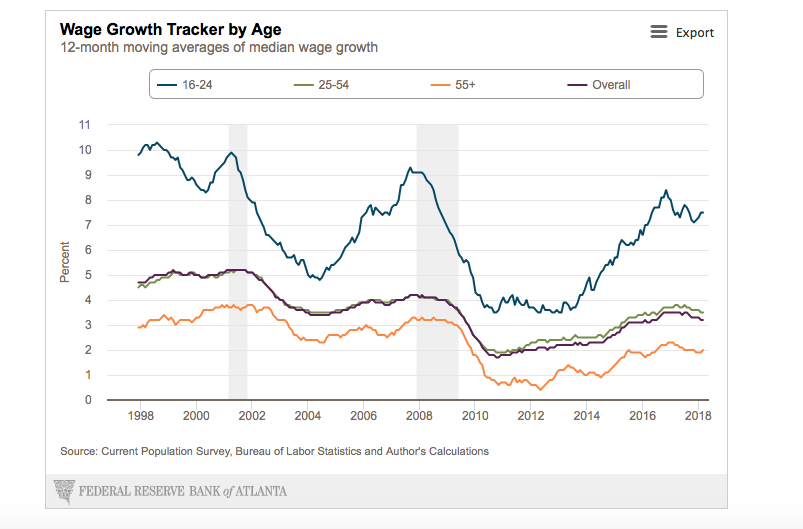
by Kate Evert | Feb 26, 2020 | Labor Markets
The Economist claims that in a recent lecture, an esteemed economist at The University of Chicago asserted that “the decision to participate in a market is not simply about maximizing utility given a set of tastes and constraints.”
Underpinning much of what is taught and believed about economics at U of C is that all people are rational actors. But like Adam Smith, who understood that the invisible hand of efficient markets would only work within a system of moral actors, Marianne Bertrand’s research has uncovered that the labor market for women isn’t efficient within a system of societal biases.
To understand more about what Bertrand’s data reveals about the contributors to gender gaps in the labor markets Read More Here

by Kate Evert | Feb 12, 2020 | Big Data, Labor Markets
Why do analysts reach for the wrong pair of glasses the minute that the monthly job numbers are released? Maybe they have a rare form of myopia that prevents them from seeing that the greatest part of our labor force works in the service industry and focusing their attention on those implications.
I have been pouring over the statistics, articles, and analyses since Friday’s job numbers were released. Such excitement that a warm January led to gains in the Construction sector! Construction only makes up 5% of the U.S. workforce. Now, compare that percentage with the 11% of the workforce that jobs in Leisure and Hospitality comprises. Of course, analysts also singled out Manufacturing, concerned that this industry lost 12,000 jobs during the month. This trend is hardly surprising; it is one that started before the Great Recession of 2008 and continues; yet today manufacturing only employs about 8% of America’s workforce.
What catches our eye? In order to stay competitive, companies need to ignore the 3.1% the press plays up and instead pay attention to what type of employees, in what industries, with what skills, are demanding wage increases between 3.7% and 14%.
Charts that put the picture into focus:
- The number of candidates per job opening, broken out by industry. The JOLTS report, the most recent released yesterday by the BLS. Read More Here
- Individual Wage Growth between the median and the 75th percentile analysis per the Atlanta Fed. Read More Here
Perhaps the analysts drinking their cappuccinos need to get a little less excited about who is manufacturing the fancy espresso machine and pay a little more attention to the talents and current wage demands of the barista who foamed their milk. Read More Here

by Kate Evert | May 2, 2018 | Labor Markets, Skilled Labor
You may have seen the article in Monday’s WSJ that spoke about towns and companies enticing younger people to move with $5,000 to help pay student loans or pay for a house. Mike Allgrunn, an economist at the University of South Dakota, dubs these “a modern-day Homestead Act.”
From the above graph, courtesy of the Atlanta Fed, you can see the one demographic driving higher wages: youth. Run this graph through its various iterations: education, race, and census division; none of these statistical parsings come close to showing the large wage difference for just being young. Why? Because we have a shortage of young workers. Especially young, skilled workers. Here’s another great article from Reuters. Read More Here

by Kate Evert | Aug 30, 2017 | Economy, Labor Markets, Wage Increases
Figuring out what’s been going on with wage growth has been one big game of Clue. Economists have been scratching their heads trying to solve the mystery. It seems that the San Francisco Fed has focused their magnifying glass on the right things and solved the Who Done It.
The issue is that Mrs. White (remember her?) and her other Baby Boomer friends are retiring. That knife of hers has sliced nearly a full percentage point off of the growth in median weekly earnings, from 5.2% to 4.2%, on an annual basis.
Retirees being replaced by less expensive workers isn’t new; it’s always happened. It is just so much more pronounced with approximately 10,000 or so Baby Boomers (The Silver Tsunami) daily exiting the work force. Read More Here and Here

by Kate Evert | Jun 9, 2017 | Diversity, Equity, Inclusion, Human Capital, Labor Markets, Skilled Labor
Many baby boomers intend to work past retirement age, and one article contends they will potentially overcrowd the job market. The article goes on to say this could create a problem for both younger and older workers. If the overcrowding keeps wages lower, then older workers might need to work much longer to acquire the retirement savings they desire, and, “if employers end up using older workers instead of younger workers, this could also lower wages for younger workers or slow down their wage growth, the researchers say.”
But, this article presents a flawed argument, because many of the positions baby boomers currently hold are not the same jobs that are opening up for new college grads or entry level workers. In fact, some positions baby boomers fill right now are getting harder and harder to fill because of the expertise and experience level they require. Meanwhile, the reason fewer jobs were filled last month? The lack of skilled labor to fill it. Read More Here and Here

by Kate Evert | May 17, 2017 | Compensation, Economy, Labor Markets, Wage Increases
For college seniors entering the work force this year after graduation, there’s a lot to look forward to: high employment rate, higher salaries. The future is bright. Or is it? Others have a more pessimistic outlook. They paint a dimmer picture for this next generation: slow wage growth, and more inequality.
You might be left scratching your head with all the conflicting sources. Here’s what’s really going on: the data doesn’t lie, but it doesn’t give a full picture of what’s happening. That’s why compensation consultants are using more specific data, considering factors like industry, location, and demographic.
To read more of the positive, HERE or HERE or more of the negative HERE or HERE, but proceed with caution.






